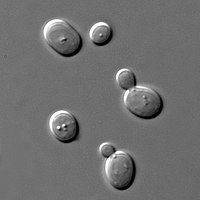
Photo from wikipedia
Rice husk ash and rice husk are waste materials generated in the rice agro-industries. This study focuses on the possibility of using these materials as adsorbents for the removal of… Click to show full abstract
Rice husk ash and rice husk are waste materials generated in the rice agro-industries. This study focuses on the possibility of using these materials as adsorbents for the removal of reactive blue dye 19. The adsorbents were characterized by employing the point of zero charge technique, scanning electron microscopy, X-ray microanalysis, and Fourier-transform infrared spectroscopy. The adsorption study was performed in a static system and by determining the influence of the initial concentration, adsorbent dose, initial pH, contact time, and temperature effect. The conditions of the removal process were established as being an initial pH 2, an adsorbent dose of 1 g/100 mL, and an equilibrium time of 120 min. A kinetic study was performed, and the data obtained for rice husk ash as regards blue dye 19 adsorption fitted best to the Bangham model, while those obtained for RH fitted best to the pseudo-second order and Bangham models. The equilibrium isotherms were analyzed by employing the Langmuir, Freundlich, Toth, and Sips models, and the Langmuir and Toth models proved to be the best representatives of blue dye 19 adsorption for both rice husk ash and rice husk. The thermodynamics of the adsorption process was studied, showing that the rice husk/blue dye 19 and rice husk ash/blue dye 19 removal systems were spontaneous and exothermic.
Journal Title: Biomass Conversion and Biorefinery
Year Published: 2020
Link to full text (if available)
Share on Social Media: Sign Up to like & get
recommendations!